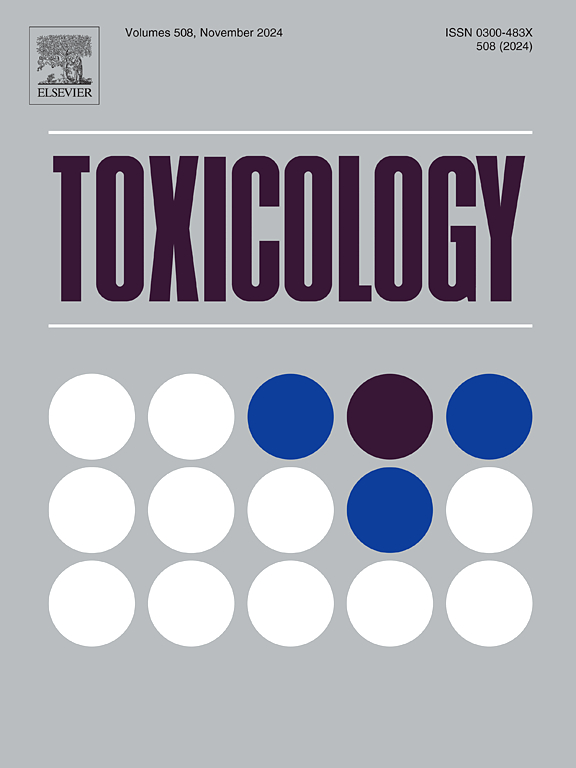Amitraz mechanisms of cytotoxicity in a characterized SH-SY5Y cells spheroid model
IF 4.6
3区 医学
Q1 PHARMACOLOGY & PHARMACY
引用次数: 0
Abstract
In recent years, spheroids (tridimensional cell cultures) have emerged as a more physiologically relevant replacement for monolayer models. Their distinctive advantage is the formation of an extracellular matrix that facilitates enhanced cellular interaction and communication, approximating the conditions observed in vivo. Therefore, the potential for conducting intricate cellular and molecular techniques in these models could offer a more precise assessment of pivotal proteins within various cellular pathways of interest. Amitraz (AMZ), an acaricide classified as a formamidine chemical, has been detected in honey at concentrations exceeding legal limits. The objective of this study was to characterize a spheroid model of SH-SY5Y cells and determine the cytotoxic effect of AMZ and its mechanisms of action on this spheroid. The formation of mature spheroids was observed on the seventh day following seeding. The results obtained with SH-SY5Y spheroids were an IC50 of 238.8 ± 17 µM and 224.3 ± 19 µM, respectively, after 24 and 48 h of exposure by the MTT assay. The findings revealed that AMZ did not exhibit any indications of inflammatory over-expression markers in the spheroids. Nevertheless, at 238.8 µM of AMZ, an increase incidence of late apoptosis within spheroid cells and Bcl-2 protein expression in peripheral spheroid cells were observed through annexin V and propidium iodide probe and immunofluorescence analysis. In conclusion, the results demonstrated that spheroids could be useful for an accurate assessment of toxicity, representing a viable alternative method for determining the mechanisms of action of AMZ and related compounds.
双甲脒在特征化 SH-SY5Y 细胞球形模型中的细胞毒性机制。
近年来,球形细胞(三维细胞培养物)已成为单层模型的一种更具生理相关性的替代物。它们的独特优势在于能形成细胞外基质,有利于增强细胞间的相互作用和交流,接近体内观察到的情况。因此,在这些模型中进行复杂的细胞和分子技术研究,可以对各种相关细胞通路中的关键蛋白进行更精确的评估。双甲脒(AMZ)是一种杀螨剂,被归类为甲脒类化学品,在蜂蜜中检测到的浓度已超过法定限值。本研究的目的是描述 SH-SY5Y 细胞球体模型的特征,并确定 AMZ 对该球体的细胞毒性作用及其作用机制。在播种后第七天观察到成熟球体的形成。通过 MTT 试验,SH-SY5Y 球形细胞暴露 24 小时和 48 小时后的 IC50 分别为 238.8 ± 17µM 和 224.3 ± 19µM。研究结果表明,AMZ 没有在球体内显示出任何炎症过度表达标记物的迹象。不过,在 AMZ 浓度为 238.8µM 时,通过附件素 V 和碘化丙啶探针以及免疫荧光分析,观察到球形细胞内晚期凋亡发生率增加,外周球形细胞中 Bcl-2 蛋白表达增加。总之,研究结果表明,球形细胞可用于准确评估毒性,是确定 AMZ 和相关化合物作用机制的另一种可行方法。
本文章由计算机程序翻译,如有差异,请以英文原文为准。
求助全文
约1分钟内获得全文
求助全文
来源期刊

Toxicology
医学-毒理学
CiteScore
7.80
自引率
4.40%
发文量
222
审稿时长
23 days
期刊介绍:
Toxicology is an international, peer-reviewed journal that publishes only the highest quality original scientific research and critical reviews describing hypothesis-based investigations into mechanisms of toxicity associated with exposures to xenobiotic chemicals, particularly as it relates to human health. In this respect "mechanisms" is defined on both the macro (e.g. physiological, biological, kinetic, species, sex, etc.) and molecular (genomic, transcriptomic, metabolic, etc.) scale. Emphasis is placed on findings that identify novel hazards and that can be extrapolated to exposures and mechanisms that are relevant to estimating human risk. Toxicology also publishes brief communications, personal commentaries and opinion articles, as well as concise expert reviews on contemporary topics. All research and review articles published in Toxicology are subject to rigorous peer review. Authors are asked to contact the Editor-in-Chief prior to submitting review articles or commentaries for consideration for publication in Toxicology.
 求助内容:
求助内容: 应助结果提醒方式:
应助结果提醒方式:


